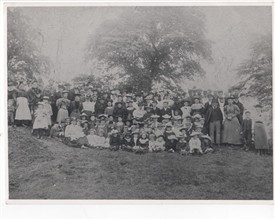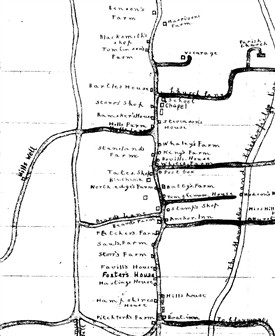Hayton in the First World War

Village Outing

Map of Hayton drawn in 1908 by schoolboy Walter Storrs who joined the KOYLI who was wounded and discharged April 1918.
By Elizabeth Powell
Hayton is a small agricultural village which is about 3½ miles from Retford. In the 1911 census the population was 205. It was very self-contained village with 16 farms, 2 blacksmiths, 3 shops and 2 pubs also a dressmaker, carpenter, wheelwright and tailor – most things could be found in the village – even a gunsmith. Some rural workers had left the area because of a slump in the prices for farm produce – as due to improved transport, refrigeration and canning techniques foreign goods had flooded the market. Agriculture was becoming less labour intensive as more and more machinery was introduced onto the farms. The main crops were wheat, barley, peas and beans.
There were 3 market gardens mainly employing women. They transported their goods to markets in Sheffield and Leeds by train. Other heavier goods were transported by canal barges On market day the Haytonians were up very early to take their goods by barge to town.
Hayton had a school which although built to hold 60 never held more than 25 pupils.
St. Peter’s Church which dates from 1120 had a Vicar living in the vicarage. A Wesleyan Methodist Chapel which had been built in 1823 on a piece of land which cost £2.00 and a building which cost £140. 00 with money raised by the villagers.
Social events were popular – we read of a Harvest Festival in 1910 where the church was packed and over 100 people sat down in the vicarage grounds for Harvest Tea after which there was some entertainment with songs and music from Rowleys Mammoth Gramophone. There were frequent concerts at the village school.
It is quite possible that news of the shooting of the Archduke Franz Ferdinand was not particularly important in Hayton but upon the outbreak of war in August 1914 27 young men of the village joined the army.
The goods which we had been importing from America and Canada were suddenly in short supply due to the introduction of submarine warfare and the many merchant ships which were torpedoed. In Hayton this was good news for the farmers. There was a demand for home produced food. Those who would have worked on the land – young men – had been called up, so often the work was done by Womens Land Army or conscientious objectors. One big problem was that most of the horses had been requisitioned for the Cavalry. In Hayton only the very oldest horses were left. The horses never came back.
3 men from Hayton never came home. The first to die was the blacksmiths son Robert Emson. He was in the R.A.M.C. and met his death on 7th October 1916 while searching the battle field for the wounded. His name is inscribed on the Thiepval Memorial which dominates the skyline of the Somme battlefield.
Cyril Whitworth Parkin, a lance Corporal of the Sherwood Foresters (Notts and Derby Regt.) was killed, age 22 in September 1917, by a large trench mortar shell. He was a Lewis gunner and died together with several comrades. He is remembered with honour at Cambrin Military Cemetery, Pas De Calais, France.
Private William Tomlinson died on 28th September 1918. He was eager to ‘do his bit’ and joined the South Staffs Regiment on his 18th birthday. He is buried at the Brie British Cemetery.
The remaining 24 men came back to Hayton, some badly wounded and all scarred by their memories of the “War to end wars”.
In 2014 there was a performance held in St. Peter's Church to commemorate the start of WW1. This was called "Hayton remembers....." and was the story from the start of the war until the end of 1916 and culminated with the re-dedication of the village Roll of Honour and the dipping of the flag by the British Legion flag bearer. Also a promise to present the ending of the war in 2018. Hayton will this year will "Celebrate 1918" with 2 events - on 21st July a family outdoor even which hopes to re-create a fete of 1918 complete with re-enacters, suffragettes, displays by British Legion, RAFA and other items of interest. Children's games and Afternoon Tea will add to the atmosphere. On 15th September there will be a presentation on stage following the events from 1916 until the signing of the Armistice in November 1918. Again this will consist of music and prose of the period alongside a PowerPoint presentation.